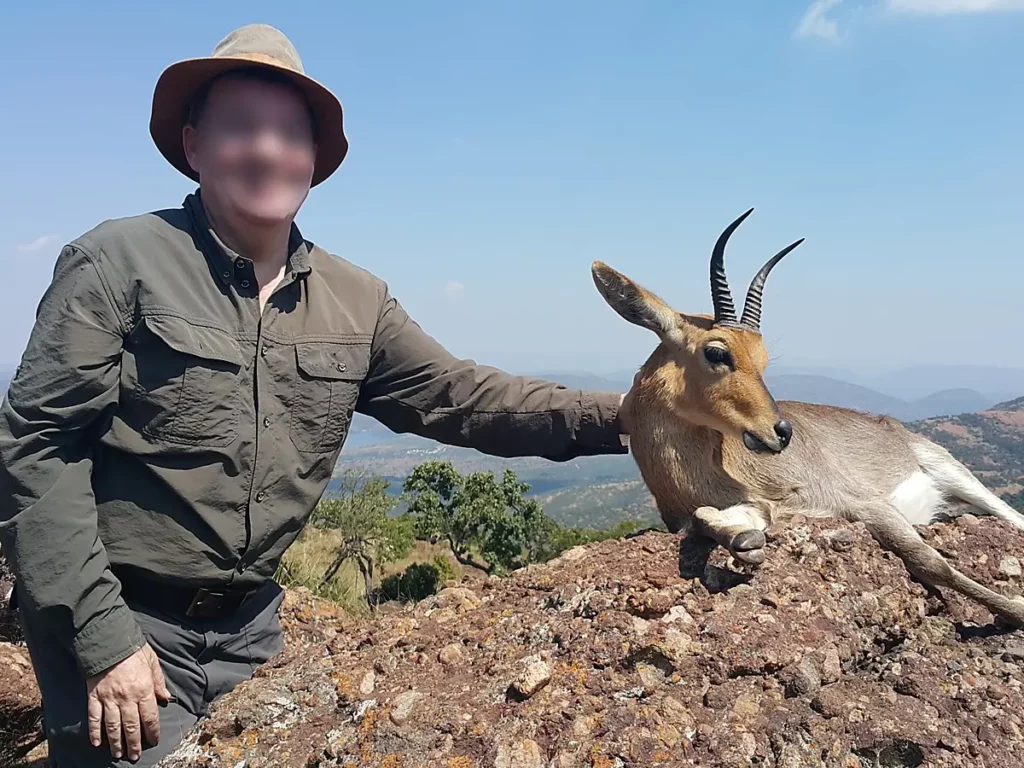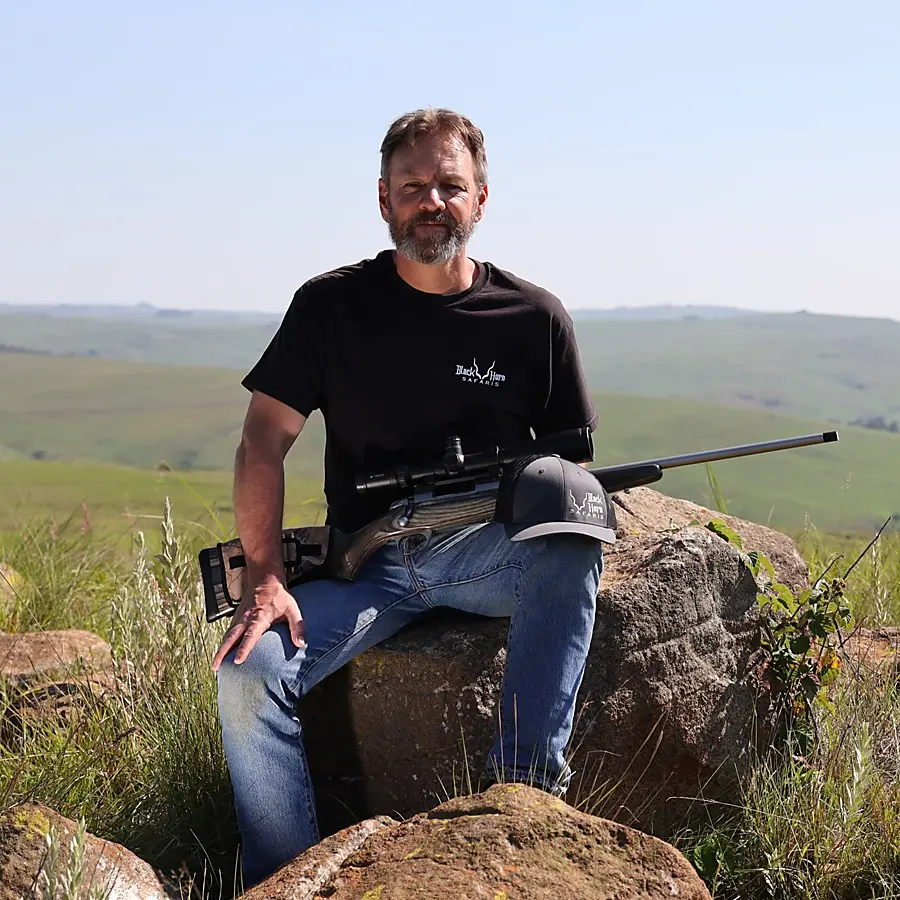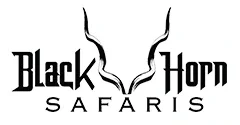Hunting Mountain Reedbuck introduces an unparalleled experience. These graceful antelope inhabit the rocky mountainous terrains of Southern Africa, thriving in high-altitude areas rich in their preferred grasses. These animals are known for their excellent sense of hearing and sight, making them one of the more challenging species to hunt. The rocky terrain where they reside also adds a level of physical challenge, requiring hunters to be in good physical shape to navigate the steep slopes and uneven ground. Find out all you need to know for a hunt in South Africa for Mountain Reedbuck including prices, hunting packages, the best areas, rifle calibers and archery hunting.


Description and Characteristics of Reedbuck
Mountain Reedbuck (Redunca fulvorufula), are medium-sized antelope endemic to the mountainous regions of sub-Saharan Africa. They stand about 75 centimeters tall at the shoulder and typically weigh between 30 and 35 kilograms. These antelope are characterized by their distinctive grey coat, white underbelly, and a bushy, white tail that they display prominently when alarmed. Males sport ridged, forward-curving horns that can reach lengths of up to 11 inches. Mountain Reedbuck are known for their agility and speed, adeptly navigating the rocky terrain of their habitat. These plains game animals are most active during the early morning and late afternoon hours, and they’re usually found in small groups of about four to five individuals. Their diet mainly consists of grasses, and they are dependent on water, requiring a daily drink.
Trophy Size
The trophy size of a Mountain Reedbuck is primarily determined by the length and curve of the rams horns. Mature rams sport elegant, ridged horns that curve forward and slightly inward, tapering from base to tip. An impressive trophy typically features horns measuring 7 inches or more in length, although this can vary depending on the specific region and subspecies of Mountain Reedbuck. The overall quality of a trophy is also affected by the symmetry of the horns and their aesthetic appeal. Sportsmen pursuing these elusive antelope should focus on identifying mature rams with prominent horn development, which often requires a keen eye and practice. A striking Mountain Reedbuck trophy serves as a lasting reminder of the hunter’s skill, perseverance, and respect for these unique animals. Minimum for entry into the Rowland Ward record book is 6 while Safari Club International require a score of 11.
Best Locations for Mountain Reedbuck Hunts in South Africa
Mountain Reedbuck are found across the mountainous regions of sub-Saharan Africa, but certain locations are particularly renowned for offering an exceptional hunting experience. South Africa, especially the Eastern Cape and KwaZulu-Natal regions, boasts substantial populations of Mountain Reedbuck in their native high-altitude habitats. These areas provide the rugged, rocky terrain that these antelopes prefer. Similarly, the rolling hilly terrains of Mpumalanga offer vast tracts of land where these animals thrive. Zimbabwe’s eastern highlands, known for their lush grasslands and cool climate, also provide ideal conditions for this species. These destinations offer not only the opportunity to hunt this elusive species but also to immerse oneself in the stunning natural beauty and rich biodiversity of Africa. Experienced hunting outfitters in these regions can help ensure a successful and ethical hunting experience.
Rifle Hunting and Calibers
Choosing the right rifle and caliber is of paramount importance for Mountain Reedbuck. Given their medium size, a hard hitting rifle is not necessary and might even damage the trophy. A bolt actioned rifle chambered in a medium caliber such as .243 Winchester, .260 Remington, .270 Winchester or .308 Winchester tends to be ideal. These calibers offer a good balance between flat trajectory, resistance to wind drift and recoil, ensuring a humane kill without the impact being more disruptive than necessary. It is important to note that Mountain Reedbuck are often found in rocky, steep terrain, so the rifle chosen should be light, reliable and sturdy enough to withstand these conditions. In the end, the best choice will depend on the hunters personal preference and proficiency with their chosen firearm for rifle hunting.
Rifle Scopes to Hunt Mountain Reedbuck
To hunt Mountain Reedbuck is challenging and requires specialized equipment, with regards to rifle scopes. These elusive animals inhabit the rocky terrains and high altitude grasslands of Southern Africa, and are adept at camouflaging themselves, making them a difficult target even for seasoned hunters. To counter this a quality rifle scope with good magnification and light-gathering capabilities becomes prerequisite. Optics with variable power settings, ranging from 4-12x or 5-15x magnification, are typically preferred due to the diversity of the terrain and longer distances of shots. Scopes with multi-coated lenses are valuable as they ensure optimal light transmission, particularly during dawn and dusk when Reedbucks are most active. An adjustable objective for parallax correction is another key feature that enhances accuracy at extended ranges. Rifle scopes with hold off reticles and dial up turrets make life easier.
Best Shot Placement
Hunting the Mountain Reedbuck is a study in precision and patience, with the perfect shot placement being paramount for success. Two preferred shot placements are the quartering away shot and the broadside shot. The quartering away shot is taken when the Reedbuck is positioned at an angle, facing away from the hunter. The point of aim is for the bullet to exit the offside shoulder, this ensures that the bullet will pass through the vital organs – heart and lungs – ensuring a swift and humane kill. Conversely, the broadside shot is taken when the animal is standing perpendicular to the hunter. This shot provides a larger target area, making it easier to hit the vital organs of the Mountain Reedbuck. Both the quartering away and broadside shots have their advantages, but they require the hunter to be patient and wait for the shot to present itself correctly. As with all ethical hunting, the ultimate goal is a clean, humane kill that minimizes the animals suffering.


Bow Hunting Reedbuck
Bow hunting Mountain Reedbuck requires a deep understanding of your equipment and arrow trajectory. Light, fast arrows are important as they have less drop and a flatter trajectory, making them more likely to arrive on target accurately, especially at longer distances. With shots often taken from 40 to 50 yards, due to the skittish nature of these animals, the speed and flight path of the arrow becomes even more critical. Take into account the steepness and angle of the terrain often encountered when hunting Mountain Reedbuck. In addition, wind will play a significant role in this scenario, as it can cause an arrow to drift in flight, requiring the hunter to adjust their point of aim and shooting technique accordingly.
The best success in bow hunting Mountain Reedbuck often comes from a bow blind positioned over water. These animals need to drink regularly, and setting up a strategic position overlooking their watering spot increases the chances of a successful hunt, as the hunter can patiently wait for the perfect moment to release his arrow.
Bow Hunting Equipment
Bow hunting Mountain Reedbuck necessitates the use of specialized equipment tailored to the unique challenges posed by these elusive animals. Light, fast arrows are a critical component of a successful hunt, a good crossbow can be beneficial. Lighter arrows, characterized by their flatter trajectory, increase accuracy at longer distances, which is often required when hunting Reedbucks. The lighter weight results in a faster flight speed, and the flatter trajectory reduces the margin of error in distance estimation, both of which are essential in mountainous terrains. Mechanical broad heads are highly recommended. Good quality open on impact mechanicals have blades that stay closed during flight to maintain the speed and accuracy of the arrow, and expand on impact, causing significant damage to the animal and increasing the likelihood of a swift, humane kill on Mountain Reedbuck. The combination of light, fast arrows and mechanical broad heads can significantly enhance a hunter’s success rate when pursuing Mountain Reedbuck on an African hunting safari.
Prices and costs of a Hunting Safari
The standalone trophy fee or price to hunt a Mountain Reedbuck is $ 1 650, confirm prices with the outfitter.
This price does not include the hunting day fee of $ 350 per hunter per day, hunting 2 on 1 (Two hunters sharing one Professional Hunter).
A five day hunt including the day fee and trophy fee for a Mountain Reedbuck will cost $ 3 400.
Reedbuck Hunting Packages
A Mountain Reedbuck and Grey Rhebuck package will cost $ 5 850.
This is a 7 day hunting package including a trophy Grey Rhebuck and a Mountain Reedbuck.
Included in this package hunt:
- Accommodation
- Meals
- Water and soft drinks
- The services of a Professional Hunter
- Field preparation of trophies
- Delivery of trophies to the Taxidermist
- Road transportation to and from Johannesburg International Airport
This is a fully guided hunt. Consult your hunting outfitter for up to dated prices as these can change.
FAQ’S Frequently asked Questions
How big is a trophy?
An impressive Mountain Reedbuck trophy typically has horns measuring 6 inches or better in length, although this can vary depending on the region that the hunt takes place in. A good pair of symmetrical horns with well developed mass at the bases and sharp even points that is longer than 6 inches makes an excellent trophy Mountain Reedbuck.
How much does Hunting Mountain Reedbuck cost?
The standalone trophy fee or price to hunt a Mountain Reedbuck is $ 1 650.
A five day hunt including the day fee and trophy fee for a Mountain Reedbuck will cost $ 3 400.

Adrian Anderson first obtained his Professional Hunters license in 1991. He is a Big Five and Dangerous Game licensed Professional Hunter and Hunting Outfitter. He has a tremendous love for wildlife and the African bush and enjoys sharing his knowledge with the hunting clients that he guides. Guiding hunters in Africa’s wild places is a passion and seeing them succeed with their goals brings satisfaction. With knowledge of the Safari industry built up over 32 years he is well qualified to give guidance to his hunting clients.
